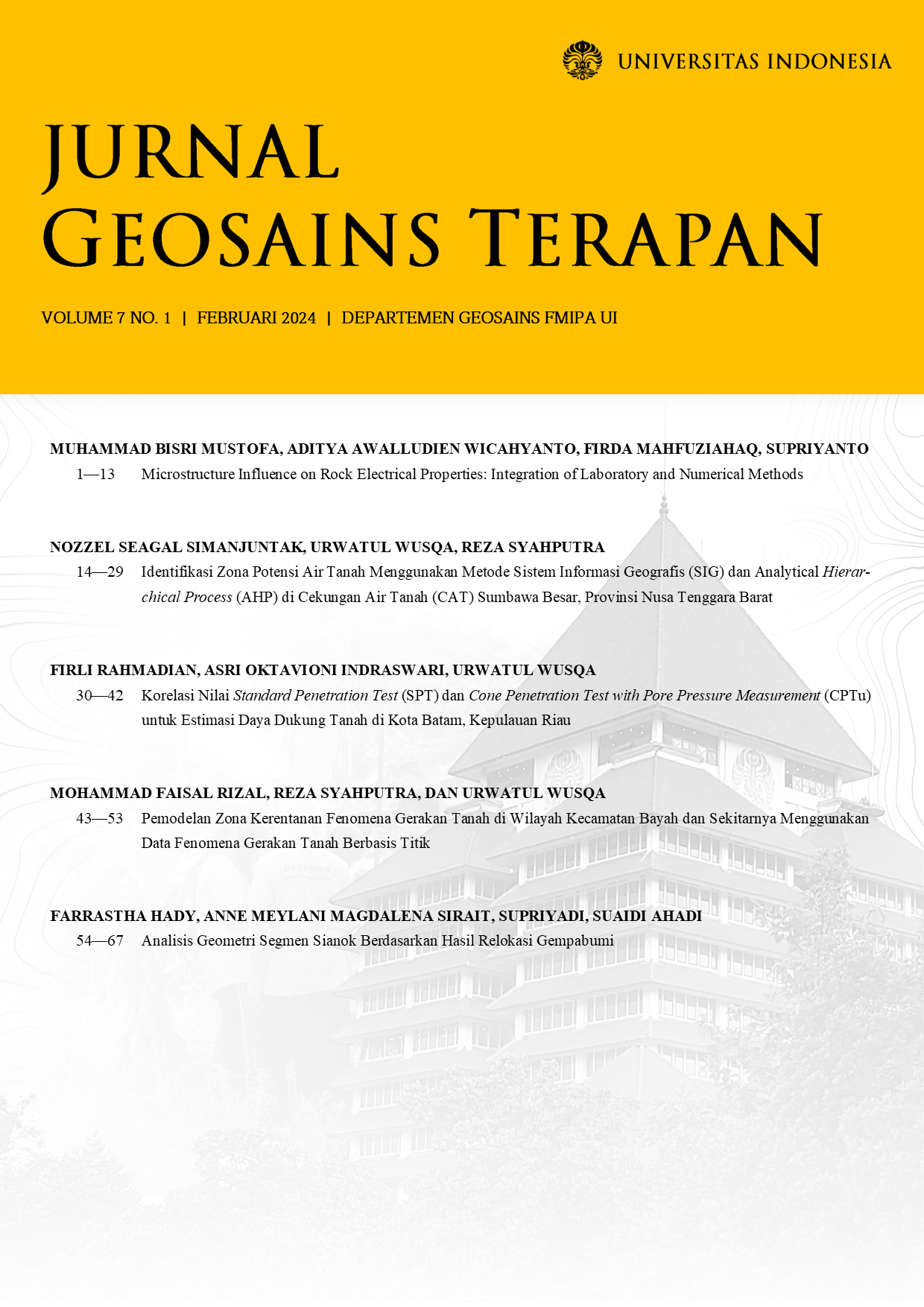Microstructure Influence on Rock Electrical Properties: Integration of Laboratory and Numerical Methods
DOI:
https://doi.org/10.64986/jgt.v7i1.116Kata Kunci:
Electrical Resistivity, Ngrayong Formation, Laboratory Measurements, Numerical CalculationAbstrak
The electrical properties of rocks are widely used in characterizing reservoir rocks due to their ability to identify porosity, fluid types, and saturation levels. This study aims to determine the effect of microstructure on the electrical properties of Ngrayong Formation rocks through laboratory measurements and numerical calculations. Twelve samples from three-grain size categories with porosity ranges of 34-48% were prepared for resistivity measurements under partially and fully brine-saturated conditions using a 6% NaCl solution. Scanning results of the three categories revealed that grain size influences the microstructure of rocks, including the distribution of grain size and pore size. The estimated electrical properties show that at low saturation, microstructure significantly affects resistivity response. Conversely, at high saturation, variations in microstructure tend to result in uniform resistivity, indicating minor microstructural influence on high-saturation electrical property estimations. Additionally, Archie parameters were determined with ranges of 2.1-3.4 for the cementation exponent and 1.2-2.4 for the saturation exponent. A strong correlation was also observed between laboratory measurements and numerical calculations, especially for samples with small grain sizes. This study provides a deeper understanding of the electrical properties of rocks as a function of their microstructure, which can serve as a base for interpreting electrical data from Routine/Special Core Analysis, resistivity log data, or field resistivity data in Applied Geophysics.
Referensi
Andrä, H., Combaret, N., Dvorkin, J., Glatt, E., Han, J., Kabel, M., Keehm, Y., Krzikalla, F., Lee, M., Madonna, C., Marsh, M., Mukerji, T., Saenger, E. H., Sain, R., Saxena, N., Ricker, S., Wiegmann, A., & Zhan, X. (2013a). Digital rock physics benchmarks-Part I: Imaging and segmentation. Computers and Geosciences, 50, 25–32. https://doi.org/10.1016/j.cageo.2012.09.005
Andrä, H., Combaret, N., Dvorkin, J., Glatt, E., Han, J., Kabel, M., Keehm, Y., Krzikalla, F., Lee, M., Madonna, C., Marsh, M., Mukerji, T., Saenger, E. H., Sain, R., Saxena, N., Ricker, S., Wiegmann, A., & Zhan, X. (2013b). Digital rock physics benchmarks-part II: Computing effective properties. Computers and Geosciences, 50, 33–43. https://doi.org/10.1016/j.cageo.2012.09.008
Abu-Hassanein, Z. S., Benson, C. H., & Blotz, L. R. (1996). Electrical resistivity of compacted clays. Journal of Geotechnical Engineering, 122(5), 397–406.
Andra, H., Combaret, N., Dvorkin, J., Glatt, E., Han, J., Kabel, M., . . . Zhan, X. (2013). Digital rock physics benchmarks—Part I: Imaging and segmentation. Computers & Geosciences, 50, 25-32.
Archie, G. E. (1942). The electrical resistivity logs as an aid in determining some reservoir characteristics. Transactions of AIME, 146, 54–62.
Blunt, M. J., Bijeljic, B., Dong, H., Gharbi, O., Iglauer, S., Mostaghimi, P., Paluszny, A., Pentland, C. (2013). Advances in water resources pore-scale imaging and modelling. Advances in Water Resources, 51, 197–216. https://doi.org/10.1016/j.advwatres.2012.03.003
Dhamayanti, E., Raharjanti, N., & Hartati, I. (2016). Dinamika sedimentasi singkapan Formasi Ngrayong dengan analogi lingkungan pengendapan modern, studi kasus singkapan Polaman dan Braholo dengan analogi pesisir pantai Utara Jawa.
Glover, P. W. J. (2017). A new theoretical interpretation of Archie’s saturation exponent. Solid Earth, 8(4), 805–816. https://doi.org/10.5194/se-8-805-2017
Knight, R. (1991). Hysteresis in the electrical resistivity of partially saturated sandstones. Geophysics, 56(12), 2139–2147. https://doi.org/10.1190/1.1443028
Kadar, D., & Sudijono. (1993). Systematic geological map, Indonesia, Quadrangle Rembang 1509-1 and 6 Scale 1:100,000: Geological Research and Development Centre.
Latief, F. D. E., Fauzi, U., Irayani, Z., & Dougherty, G. (2017). The effect of X-ray micro computed tomography image resolution on flow properties of porous rocks. Journal of Microscopy, 266(1), 69–88. https://doi.org/10.1111/jmi.12521
Müller-Huber, E., Schön, J., & Börner, F. (2015). The effect of a variable pore radius on formation resistivity factor. Journal of Applied Geophysics, 116, 173–179. https://doi.org/10.1016/j.jappgeo.2015.03.011
Mustofa, M. B., Fauzi, U., Warsa, W., & Latief, F. D. E. (2022). Experimental and modeling of electrical resistivity changes due to micro-spatial distribution of fluid for unconsolidated sand. Journal of Petroleum Science and Engineering, 208, 109472. https://doi.org/10.1016/j.petrol.2021.109472
Mustofa, M. B., Fauzi, U., Warsa, W., Latief, F. D. E., et al. (2021). The effect of brine spatial distribution on electrical resistivity during imbibition processes in unconsolidated sands. Journal of Applied Geophysics. https://doi.org/10.1016/j.jappgeo.2021.104441
Nababan, B., Zanetta, E., Novia, N., & Handoyo, H. (2019). Estimasi nilai porositas dan permeabilitas dengan pendekatan digital rock physics (DRP) pada sampel batupasir Formasi Ngrayong, Cekungan Jawa Timur bagian utara. Jurnal Geofisika Eksplorasi, 5(3), 193–203. https://doi.org/10.23960/jge.v5i3.34
Pringgoprawiro, H. (1983). Biostratigrafi dan paleogeografi Cekungan Jawa Timur Utara: Suatu pendekatan baru. Institut Teknologi Bandung.
Sezgin, E. E., & Akın, M. (2013). Sensitivity of Archie’s parameters (m and n) in prediction of reservoir fluid saturation and porosity. Journal of Petroleum Science and Engineering, 107, 63–71. https://doi.org/10.1016/j.petrol.2013.04.009
Torskaya, T., Shabro, V., Torres-Verdín, C., Salazar-Tio, R., & Revil, A. (2014). Grain shape effects on permeability, formation factor, and capillary pressure from pore-scale modeling. Transport in Porous Media, 102(1), 71–90. https://doi.org/10.1007/s11242-013-0262-7
Tariq, M. R., & Kazi, M. R. (2017). Optimization of Archie’s Law parameters for estimating porosity and fluid saturation in carbonate reservoirs. Journal of Petroleum Technology, 69(12), 1241–1255. https://doi.org/10.2118/1234567-JPT
Vozar, J., & Gurevich, B. (2014). Sensitivity of electrical resistivity tomography to geological structures: A numerical study. Geophysics, 79(2), B35–B47. https://doi.org/10.1190/geo2013-0456.1
Zhou, Y., & Zhang, L. (2020). Use of geoelectric resistivity method for geological structure delineation and groundwater exploration in fractured rocks. Journal of Hydrology and Earth System Sciences, 24(6), 2041–2055. https://doi.org/10.5194/hess-24-2041-2020
Unduhan
Diterbitkan
Cara Mengutip
Lisensi
Hak Cipta (c) 2024 Jurnal Geosains Terapan

Artikel ini berlisensi Creative Commons Attribution-NonCommercial-NoDerivatives 4.0 International License.


